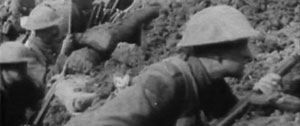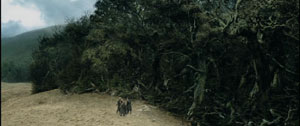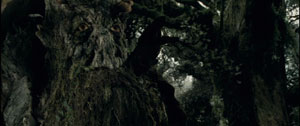| > cMusicWeb.com > Features > Meanderings > #5: Fangorn and the Church |
|

|
|
|||
|
|
|
|
|
|
THEMUSIC
|
|||
|
|
|||
|
|
|||
|
CURRENTS
|
|||
|
|
|||
|
|
|||
|
SEARCH
|
|||
|
|||
|
|
|||
|
cMUSICMAIL
|
|||
|
|||
|
|
|||
"I dislike Allegory, the conscious and intentional allegory," J.R.R. Tolkien wrote in an oft-quoted 1951 letter. What media pundits never do is let the British author finish his thought: "Yet any attempt to explain the purport of myth or fairy tale must use allegorical language" (The Letters of J.R.R. Tolkien, Letter #145).
 There is a distinction between the obvious parallels of an allegory and the symbolism of a type (i.e. a myth), defined as "a person or thing believed to foreshadow another." For example, if one saw the "Rings" saga as a metaphor for World War II, the One Ring might play the part of nuclear energy. Or, as other popular interpretation goes, Middle-earth's neighboring countries of Rohan and Gondor could represent the on-and-off relationship of rural Scotland and imperial England, ever unsure of whether to lend aid to each other.
There is a distinction between the obvious parallels of an allegory and the symbolism of a type (i.e. a myth), defined as "a person or thing believed to foreshadow another." For example, if one saw the "Rings" saga as a metaphor for World War II, the One Ring might play the part of nuclear energy. Or, as other popular interpretation goes, Middle-earth's neighboring countries of Rohan and Gondor could represent the on-and-off relationship of rural Scotland and imperial England, ever unsure of whether to lend aid to each other.All this makes for stimulating thought, but where would Tolkien have readers of his epic fiction look for types? Another selection from his "Letters" holds the answer. "The Lord of the Rings is of course a fundamentally religious and Catholic work... [wherein] the religious element is absorbed into the story and its symbolism" (Tolkien, Letter #172).
 So it is — like an Elf, a Man and a Dwarf tracking two hobbits — we come across Fangorn Forest. Venturing into the dim, stuffy canopy, an intricate picture of God's relation to man becomes obvious.
So it is — like an Elf, a Man and a Dwarf tracking two hobbits — we come across Fangorn Forest. Venturing into the dim, stuffy canopy, an intricate picture of God's relation to man becomes obvious.Tolkien used vivid language to describe this place, and Peter Jackson did a phenomenal job visualizing Fangorn on the big screen. But why the mystery surrounding a bunch of old, run-down trees? I believe it's because Tolkien hid some startling truths among the towering greenery, observations about the worldwide Body of Christ.
 Three elements are at play in this Scripture-inspired metaphor: Treebeard himself (a tree-like Ent), the Entmoot to which he calls his brethren and their decision stemming from that meeting. Follow the story to its end, and one will reveal a very applicable moral.
Three elements are at play in this Scripture-inspired metaphor: Treebeard himself (a tree-like Ent), the Entmoot to which he calls his brethren and their decision stemming from that meeting. Follow the story to its end, and one will reveal a very applicable moral.Articles written by the staff.
Maintained by WebMaster Dan Ficker.
Site Design by da Man
All Material © 1999-2005 Different Media LLC
Support cMusicWeb.com
